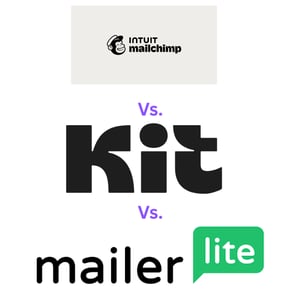Choosing the Right Email Marketing Platform: Mailchimp, ConvertKit, or MailerLite
Imagine you're hosting a party. You wouldn't greet your best friends the same way you'd greet new neighbors, right? Email marketing works similarly—you need the right platform to match your specific audience and goals. Let's dive deeply into three popular email marketing tools—Mailchimp, ConvertKit, and MailerLite—to help you select the one that feels perfectly tailored for your needs.
EMAIL AUTOMATIONEMAIL MARKETING
4/1/20255 min read


Imagine you're hosting a party. You wouldn't greet your best friends the same way you'd greet new neighbors, right? Email marketing works similarly—you need the right platform to match your specific audience and goals. Let's dive deeply into three popular email marketing tools—Mailchimp, ConvertKit, and MailerLite—to help you select the one that feels perfectly tailored for your needs.
Ease of Use: Which Platform Feels Natural?
Mailchimp can feel like stepping into a bustling, professional kitchen filled with tools and gadgets. While its extensive drag-and-drop editor offers tremendous flexibility for designing highly customized emails, it can initially overwhelm beginners. Imagine you're baking a fancy cake for the first time—you'll have all the ingredients, but you'll also face complexity that demands patience and practice.
ConvertKit offers a stark contrast. Its minimalist interface is akin to a simple, homey kitchen—everything essential is clearly labeled and easy to find, making the platform extremely user-friendly, especially for creators. For instance, if you're a blogger who values getting your newsletter out quickly without fuss, ConvertKit provides simplicity and speed.
MailerLite strikes a balance, resembling an efficiently organized kitchen where utensils are logically arranged. Beginners frequently highlight its intuitive interface as a significant advantage, often finding themselves comfortable after just a few hours of use. MailerLite enables you to effortlessly craft beautiful emails without needing extensive technical know-how.
Pricing: Which Offers the Best Value?
Mailchimp provides a free plan accommodating up to 500 contacts—a decent option if you're new to email marketing. But here's the catch: as your list grows, pricing escalates sharply, which can strain small business budgets. For example, surpassing a few thousand subscribers might lead you to significantly higher monthly expenses.
ConvertKit generously supports up to 10,000 subscribers on its free plan, making it incredibly attractive for new creators and small businesses starting out. However, once you require advanced automation or remove platform branding, the monthly costs rise noticeably. For a content creator scaling their business rapidly, this could mean budgeting carefully to manage these rising costs.
MailerLite shines with remarkable affordability. Free for up to 1,000 subscribers and offering competitively priced paid plans ($15/month for 1,000 subscribers, unlimited emails), MailerLite is a favorite among startups and budget-conscious entrepreneurs. Imagine finding a premium tool at consistently discounted rates—it’s that appealing for those mindful of their marketing spend.
Automation & Analytics: How Sophisticated Can You Get?
Automation is your digital assistant, tirelessly working behind the scenes. Mailchimp stands out with its powerful "Customer Journeys" automation builder. This visual tool allows intricate workflows, perfect for handling complex scenarios like abandoned carts or detailed customer nurturing sequences in e-commerce businesses. Moreover, its analytics offer comprehensive insights, including click maps, demographic breakdowns, and robust A/B testing.
ConvertKit excels at personal and relationship-focused automation. Imagine a course creator effortlessly sending personalized follow-ups based on whether subscribers engage with specific emails or links. ConvertKit's automation is straightforward yet powerful, driven by intuitive tagging and segmenting. Its analytics, however, provide essential data without deep dives, focusing primarily on open and click rates, suitable for creators who prefer simplicity over complexity.
MailerLite achieves a commendable balance, offering intuitive automation tools that handle most typical business scenarios comfortably. It's like having a thoughtful assistant who anticipates your needs without extensive instructions. MailerLite’s visual automation builder is accessible even to absolute beginners, and its analytics dashboard delivers clarity with just enough depth to help you make informed decisions without feeling overwhelmed.
Audience Segmentation: Can You Connect Personally?
Effective segmentation ensures your messages resonate deeply, similar to grouping guests at your party based on shared interests. Mailchimp provides extensive segmentation capabilities, using tags, groups, and segments that enable granular targeting. This sophistication is ideal for marketers who have diverse audience segments, though it requires patience to master due to its layered complexity.
ConvertKit simplifies segmentation significantly, relying primarily on intuitive tags and segments. For example, a podcast host could tag listeners based on specific episodes they've shown interest in, making targeted follow-ups effortless. This simplicity is perfect for creators needing quick, meaningful segmentation without complex management.
MailerLite combines clarity with functionality in its segmentation. It offers dynamic segments and easy-to-use groups, allowing straightforward yet effective targeting. A small business, such as a boutique, could effortlessly segment customers based on past purchases or email engagement levels, ensuring tailored promotions reach the right audience at the right time.
Integrations & Support: Who Plays Nicely With Others?
Mailchimp stands as a heavyweight in integration capabilities, widely supported across hundreds of tools—much like the popular guest who effortlessly mingles at every gathering. Whether you're connecting an online store, CRM, or a custom app via API, Mailchimp probably supports it. However, direct support for free users becomes limited quickly, pushing users towards self-help resources.
ConvertKit integrates smoothly with tools frequently used by creators, such as WordPress, Shopify, Teachable, and Stripe. Its standout feature is around-the-clock live chat and email support—even on free plans—making it feel like you have a reliable mentor always available when needed.
MailerLite covers all critical bases, including integrations with popular e-commerce and web-building platforms like Shopify, WooCommerce, Wix, and WordPress. Its robust support—responsive and helpful—earns it regular praise from users. It's akin to a dependable friend who's always quick with assistance, ensuring you're never stranded when encountering challenges.
Deliverability: Will Your Emails Reach the Inbox?
Deliverability is crucial—it ensures your messages don't get lost. MailerLite consistently ranks among the highest in deliverability tests, indicating its emails reliably land in inboxes rather than spam folders. Mailchimp also performs strongly in this area, often slightly edging out ConvertKit. However, ConvertKit's text-focused email format often naturally helps with inbox placement, as simpler emails are less likely to trigger spam filters.
Ideal Use Cases: Which Platform Aligns With Your Goals?
Mailchimp: Ideal for small to medium-sized businesses requiring comprehensive features, detailed analytics, advanced automation, and strong multi-channel integration capabilities, particularly beneficial for e-commerce brands.
ConvertKit: Perfect for creators, bloggers, online course providers, and digital entrepreneurs focused on building authentic connections through straightforward yet effective automation and segmentation. Its minimalist approach aligns perfectly with the needs of content creators.
MailerLite: Excellent for startups, small businesses, freelancers, and budget-conscious organizations seeking intuitive features, great deliverability, ease of use, and affordable pricing. It strikes a commendable balance between simplicity and functionality.
Final Thoughts & Feedback Loop
Selecting an email marketing platform boils down to aligning features with your specific needs and growth trajectory. Consider these reflective questions:
Do you prioritize sophisticated analytics and complex workflows, or simplicity and ease of use?
Is budget control critical, or are you willing to invest more for advanced features as your audience grows?
How important are integrations and immediate, responsive customer support to your business operations?
I'd genuinely appreciate your feedback on this guide. Did the expanded details clarify your decision-making process? Were the real-world examples and technical insights balanced effectively? Your insights help refine and improve content tailored precisely to your needs.
Ultimately, the best email marketing platform is the one that fits seamlessly into your strategy, helping you foster genuine relationships and drive consistent growth with authenticity and ease.
You can download or refer the below table for a quick overview of the three platforms.


© 2025. All rights reserved.
